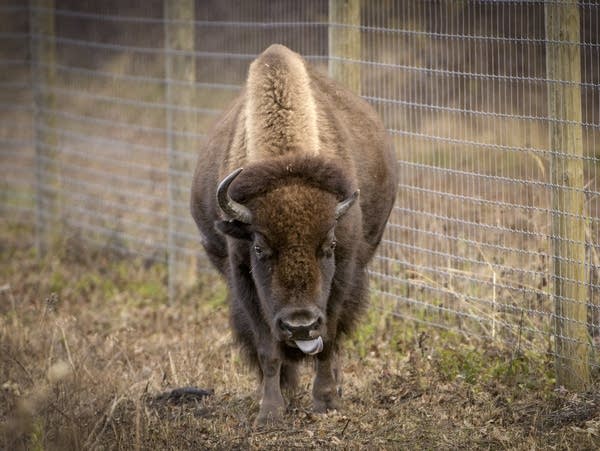New bison herd roams prairie at Dakota County park
The herd of eight animals will help restore the land and boost genetic diversity.

Go Deeper.
Create an account or log in to save stories.
Like this?
Thanks for liking this story! We have added it to a list of your favorite stories.
A new bison herd is roaming near the Mississippi River in the south Twin Cities metro. Spring Lake Park Reserve in Dakota County is the latest place in Minnesota to welcome the giant mammals. It’s part of a decadeslong effort to both increase their numbers and restore native prairie lands.
As a gusty wind blows dry prairie grass on an unseasonably warm November afternoon, Carleigh Dueck drives her pickup truck at a cautious pace past a tall gate, and into a new bison habitat.
“We think they’re up over here. We’ll see if we can’t find them in their preferred spots.”

Evidence of the animals’ presence is all over the dusty ground, some of it quite fresh. But it’s a few minutes before Dueck, a natural resources technician for Dakota County Parks, spots the bison, which are a few hundred yards away.
Turn Up Your Support
MPR News helps you turn down the noise and build shared understanding. Turn up your support for this public resource and keep trusted journalism accessible to all.
“They’re moving. I see one.”
They soon spot the truck and amble over.
“They are curious. I would put your arms in if I were you. Right there, we’re looking at the lead cow. That’s our 8-year-old right there.”

Soon another cow follows, along with two calves and a yearling. A pair of 2-year-olds stays behind. The seven bison arrived here at Spring Lake Park Reserve a month ago from Minneopa and Blue Mounds state parks. They’re part of Minnesota’s conservation herd which scientists hope will improve the genetic diversity of a species that European settlers hunted to near extinction in the 19th century.
The 1,200 pound cows appear docile, but as they move closer to the pickup Dueck decides to drive away. “They’re getting a little too curious for my taste.”
After following the truck back toward the entrance gate, one of the cows wallows in a mound of sand, rolling onto her back to scratch an itch.
In addition to preserving the animals themselves, Dakota County Parks Natural Resources Manager Tom Lewanski said restoring the prairie is the other reason for reintroducing bison to this former farmland.

“Their wallowing opens up the ground. It exposes mineral soil so that seeds can germinate and grow,” Lewanski said. “Their wallows also condense down the soil to hold water, providing drinking water for other species on the prairie, as well as breeding habitat for things like frogs and toads.”
Dakota County is funding the project with $560,000 from the Minnesota Environment and Natural Resources Trust Fund, plus another $851,000 in state bonding money.
According to the Minnesota Department of Natural Resources, there are about 370,000 bison in North America. Most are raised as livestock. About eight percent are in conservation herds.
Lewanski said the park along the Mississippi River has set aside 150 acres for the bison — enough land for 15 animals. It’s divided into eight, separately fenced paddocks. The bison are able to move between most of them on their own. The layout helps park staff manage both the animals and the land, and also accommodate visitors.
“There is the Mississippi River Greenway that winds through this section of the park. And so we had to break up the larger prairie into smaller chunks so the bikers and the bison were not co-existing in the same spot,” Lewanski said.
Park managers are getting advice on this new effort from experts at the nearby Prairie Island Indian Community, which has had its own herd for about 30 years. Tribal Council Treasurer Michael Childs Jr. says the animals, which are also known as buffalo, sustained the Dakota people for centuries and remain central to their culture.
“It gives more people more opportunity to see the buffalo herds. It’s helping us to share the story of buffalo and how this country was pre-settlement,” Childs said.
Visitors to Spring Lake Park Reserve who hope to catch a glimpse of the bison should bring a pair of binoculars. To help the animals acclimate to their new home, wildlife managers are keeping them in an out-of-the-way section for now. But by the spring, cyclists on the greenway should be able to get an up-close look from behind the fence.
Dueck says the small herd is expanding. An eighth bison is set to arrive next week. And by late 2024, she says wildlife managers hope to introduce a bull to this all-female group and establish a breeding herd.



